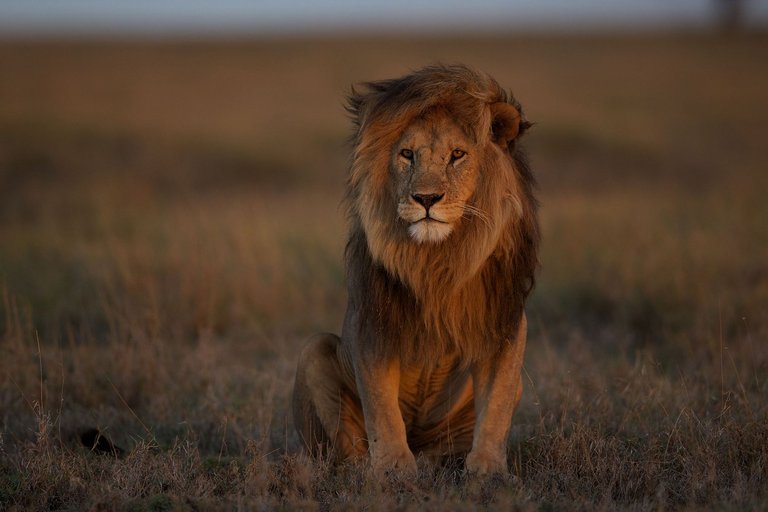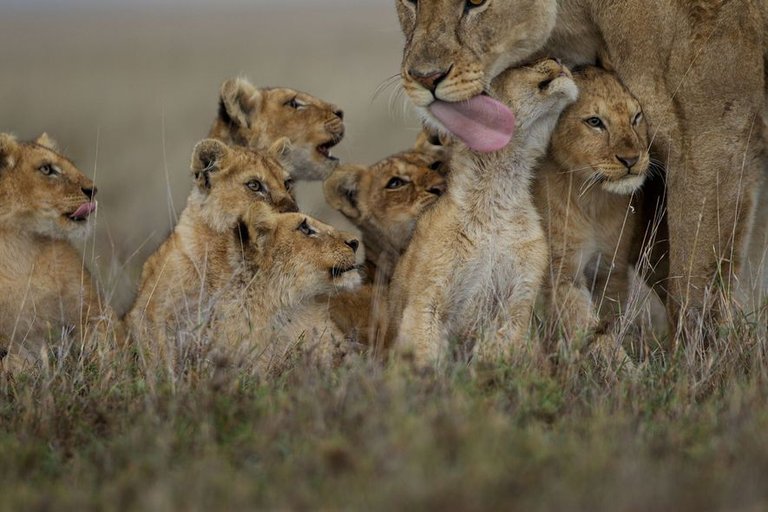25 years ago, the number of African lions was double. Conservation programs aim to protect endangered species by promoting the coexistence between lions and humans in the African savanna.

An adult male lion rests in the Serengeti. The loss of prey species, habitat loss and human invasion have caused their numbers to decrease dramatically. IUCN considers them vulnerable to extinction.PHOTO OF MICHAEL NICHOLS, NAT GEO IMAGE COLLECTION
For every lion in the wild, there are 14 African elephants and 15 western lowland gorillas. There is also a greater number of rhinos than lions.
The emblematic species has disappeared from 94 percent of its historical distribution area, which once comprised almost the entire African continent, and today has been limited to less than 1,709,392 square km. With an approximate number of 25,000 specimens in Africa, lions are considered vulnerable to extinction according to IUCN (International Union for the Conservation of Nature), which determines the conservation status of the species.
Putting the situation in perspective, the nonprofit Wildlife Conservation Network (WCN) notes that the number of lions has been halved since the Lion King was released in theaters in 1994. (The Walt Disney Company is the majority owner from National Geographic Partners).
"Lions are really one of the universal icons in the world and they are leaving little by little," says Paul Thomson, director of conservation programs for WCN. "It is time to stop this loss and re-populate the landscapes of lions. the whole continent. "
To save the emblematic Africans, conservationists are working to reduce the damages arising from living with them and highlight the local value that exists to protect them.
More prey and less poaching.
The revered predators of Africa face innumerable threats that endanger their own existence. The decrease in the wild prey of lions, which is much in demand in the wild meat trade, results in a dangerous approach - in search of food - from lions to humans and their livestock. But when felines take advantage of livestock, they can lose out, as they usually die poisoned. And as human settlements grow, the habitat of lions is lost or fractionated, making it difficult for males to find new lions for mating.
Poaching also poses a threat. The skin, teeth, legs and claws are used in traditional rituals and medicine. Also, in Asia, lion parts are becoming more and more commercialized.
Conservationists hope to stop the loss of vulnerable species by working on the coexistence of lions and humans throughout Africa. Part of the solution is to regulate the financial burden required to manage protected areas, which are the backbone of conservation, as well as protect lions in unprotected areas, says Amy Dickman, a National Geographic collaborator and researcher at the Oxford Wildlife Conservation Research Unit (WildCRU) and co-author of a 2019 report called “State of the Lion”.
"If we want that, by 50 years, the lions continue to exist and their numbers increase significantly, we must adjust the costs and benefits so that there are many more benefits at the local level and the costs are assumed at the international level," he says. Dickman.
Improve coexistence
The survival of the species depends on the work with the local communities that must coexist with the lions and the recognition of their role in protecting this species, according to Peter Lindsey, director of the Lion Recovery Fund. (The fund was founded by WCN and the Leonardo DiCaprio Foundation and is sponsored, in part, by Disney).
"Most people in the Western world have refused to live with dangerous animals. In Africa, however, many people live with dangerous animals, such as lions and elephants, with whom it is very difficult to cohabit."

One way forward is to provide tangible benefits to those who live next to the lions to collaborate with the conservation of the species. For example, some conservation models reward communities where there is an increase in the number of lions, which provides an incentive not to hunt or retaliate against them for slaughter of cattle. Compensation schemes work similarly, livestock owners are paid to replace the animals that lions attack. These types of programs can modify the general attitude of a community towards animals previously considered as a threat to safety and livelihood. Dickman says that if the benefits of living near lions can outweigh the cost, then people will choose to protect them.
It is also very important to involve communities directly in conservation. For this, Warrior Watch has been created, a project of the non-profit organization, Ewaso Lions, located in Kenya, which is sponsored by the Big Cats Initiative of the National Geographic Society. Warrior Watch recruits young people from Samburu, traditionally excluded from wildlife conservation and management conversations, to explore the surroundings of their communities in search of lions.
"If there are predators in the area, they communicate it to the shepherds who are there with their cattle," said Shivani Bhalla, founder and executive director of Ewaso Lions and a National Geographic collaborator, in a presentation at the National Geographic headquarters. In exchange for the explorations and communications of their pastors, the youth said they would like to receive education. Ewaso Lions opened a Sunday school, and now Bhalla explains that everyone in the program can read and write in Swahili.
According to surveys conducted by the organization a few years ago, the program has had a very positive impact, "We were very happy with the results," said Bhalla. "It was shown that the attitude of the locals towards the predators had improved significantly thanks to the people who worked with them. They also felt much more socially empowered as a result of this project."
What is needed for conservation?
Since 2017, the Lion Recovery Fund has invested more than five million dollars in conservation projects in 17 countries, but there is still a serious budget crisis, according to Lindsey. Many African countries have separated large areas to devote to conservation, but insufficient funding often hinders their effective management. In a 2018 study, which he conducted with Amy Dickman and others, he discovered that more than a billion dollars annually will be needed to secure lions in protected areas of Africa. Current funds only reach about $ 381 million a year.
In addition, it states that the shortage of funds, civil conflicts or remoteness also demotivate local authorities when defending protected areas.
It is essential to ensure that political leaders recognize the importance of conserving lions. Lindsey clarifies that this goes beyond the benefits of the tourism industry, which supports economic development and job opportunities. And he notes that, by protecting the natural habitats of lions, communities are promoting cleaner air and water and carbon storage, factors that are important for human health and the well-being of rural communities.
Just in time for the mid-July release of the new Lion King movie, The Walt Disney Company also joined the Lion Recovery Fund for the "Protect the Pride" campaign, which aims to educate the public about the crisis of the lion and encourage them to support conservation projects.
Although the situation of the lions is critical and the shortage of funds is serious, Lindsey is hopeful that the situation of these iconic predators can be improved, which he says are "extremely resistant." And he explains that if the protected areas of Africa receive the necessary funding to manage them properly, the current population of lions could triple.
"It is a door that we must open right now," he says. "If we wait, these wildlife populations will be lost."
good topic
Thanks.